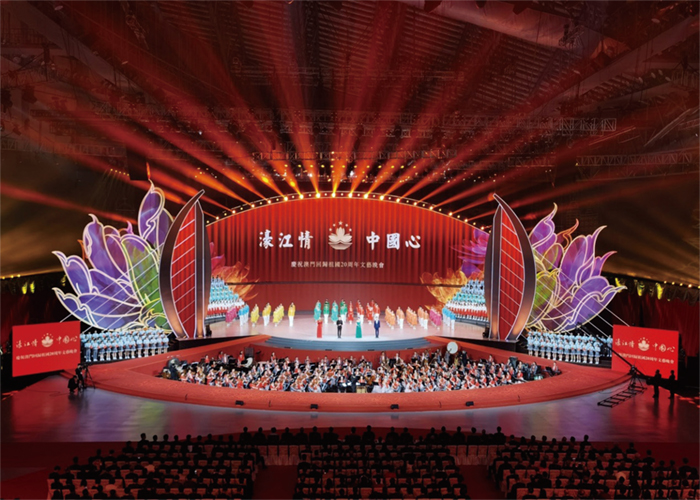
At 20 o'clock on December 19, 2019, the "Art Gala for the 20th Anniversary of Macao's Return to the Motherland" was held at the Macao East Asian Games Gymnasium. President Xi Jinping and representatives of all sectors of Macao watched this splendid audiovisual feast.
The performance is based on the theme of "The Love of Haojiang River, the Heart of China" and is divided into five chapters. The party comprehensively used various performance forms such as lead singing, chorus, dance, and scene performance, and presented a magnificent stage effect (see Figure 1) with various stage techniques such as stage art, lighting, sound, and video (see Figure 1), showing the return of Macao The remarkable achievements since.
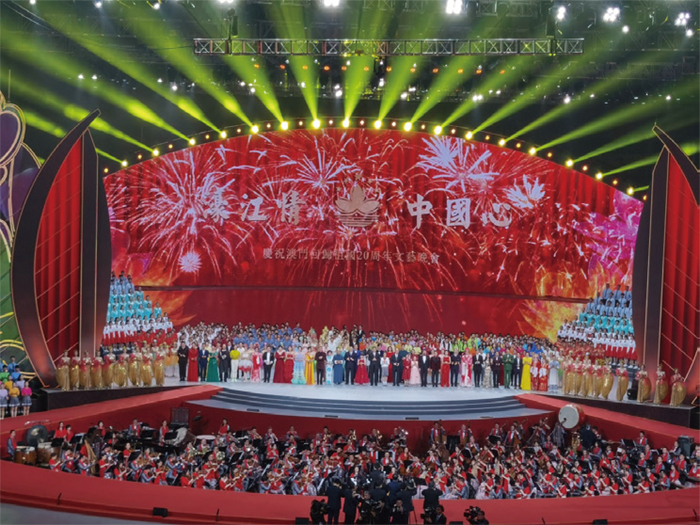
Figure 1 Theatrical performance scene
1 Site conditions and overall requirements
As the performance venue gymnasium, it is necessary to build a stage, orchestra pool and performance area in the venue. The total width of the stage is 53 m, of which the width of the platform is 40 m and the total height is 18 m. The 500 square meter orchestra pool built in front of the stage can accommodate symphony bands, folk bands and electro-acoustic bands. There are auditoriums and VIP viewing areas in the venue, as shown in Figure 2.
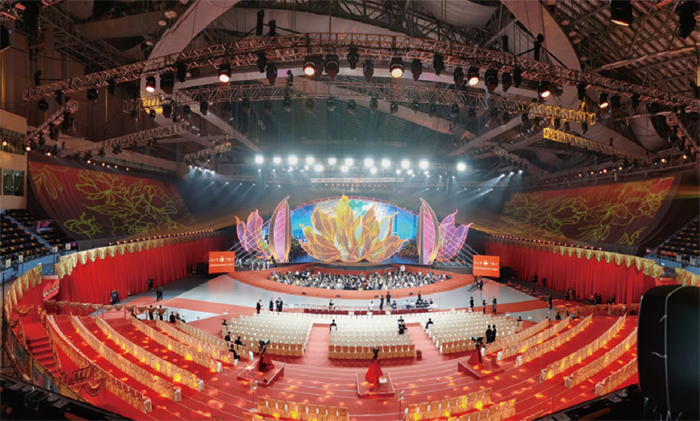
Figure 2 The layout of the venue
The performance forms are rich and varied, including solo, lead and chorus, recitation, narration, music sketch, Nanyin, Cantonese opera, a cappella (Acapella), etc. Among them, a large chorus composed of more than 200 people is separated on both sides of the stage; the instruments participating in solo, lead, and accompaniment include piano, violin, cello, guqin, Chinese drum, pipa, bamboo flute, and South Music Group. Sufficient; According to the arrangement of different programs, there are corresponding special sound effects.
The overall requirements of the director team for the audio system are: while ensuring the stage effect, the sound effect is guaranteed, the Macau dream and the humanistic style are reflected, and the soul is shocked. All of these have brought huge challenges to the pickup and expansion of live sound, and the broadcast of TV sound. The sound team of Beijing Tianyun Xingguang Culture and Art Co., Ltd. is responsible for the overall sound production (see Figure 3). The team has undertaken many times of sound production work for major national events and successfully completed the tasks, especially to help the successful holding of the mass parade and party activities celebrating the 70th anniversary of the founding of the People’s Republic of China, and accumulated rich theoretical and practical experience for the team. Below, the author outlines the sound system framework, and based on the work experience participating in this performance, focuses on the ideas, implementation and experience of live band sound mixing and broadcast sound mixing, and shares with readers.
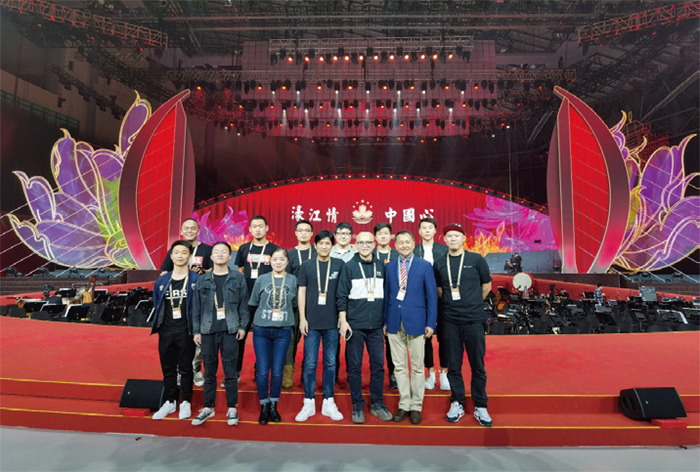
Figure 3 Audio team (three from the left in the front row: Ji Haowei, Xu Yong, Ma Wenzhao, Ma Xin, Xiao Haibao, and two from the left in the back row: Li Tao, Shen Tian)
2 System design ideas and architecture
As mentioned before, the special feature of this performance is the fusion of several different types of bands, coupled with chorus and various performances, with nearly 300 input channels. In the preliminary preparations, the sound team communicated fully with musicians and composers, and learned about the characteristics and styles of each band in their performances.
In order to meet the needs of all parties and avoid overcomplicating the structure of the entire system, a hierarchical control strategy was set at the beginning of the design, that is, the pickup microphones of the symphony orchestra, the national orchestra, and the chorus were collected into a single mixer Here, an audio engineer (the author) will adjust, process, and mix; then combine the mixed signal with each grouping signal (such as string group, woodwind group, brass group...ethnic string group, plucked group, blowpipe Group...Children’s chorus group, adult chorus group, etc.) were sent to the live sound reinforcement mixer (PA), stage monitor mixer (Monitor), broadcast mixer (OB), and the sound engineer of each mixer This mixed signal or grouping signal and other sound signals such as solo, solo, electro-acoustic band and so on that are distributed to their respective mixers are adjusted and mixed, and finally sent to the live sound reinforcement box, monitor speakers, and broadcaster. The plan not only has a clear division of labor, but also requires mutual coordination and cooperation to complete the final presentation of the performance.
PA mixer uses 2 SSL Live550, one main and one standby; Band mixing console uses 1 Digico SD7 Quantum, Monitor mixer uses 1 SSL Live200, OB mixer uses 2 Digico SD5, one master One preparation; a total of 212 wired and wireless microphones.
3 Live sound reinforcement system
In order to obtain a better sound pickup effect in the sound reinforcement and ensure that the signal at the broadcast end is sufficiently clean, in the initial sound design stage, the selection and location of the main amplifier speakers were repeatedly considered, and finally selected on the 70th anniversary of the National Day The outstanding performance of the d&b GSL series speakers on the Tiananmen Square of the celebration were used as the main amplifier speakers, 12 on each side, hung on both sides above the orchestra pool (see Figure 4, Figure 5); each side was equipped with 3 SLSUB subwoofers on the ground .

Figure 4 Hanging position of the main loudspeaker
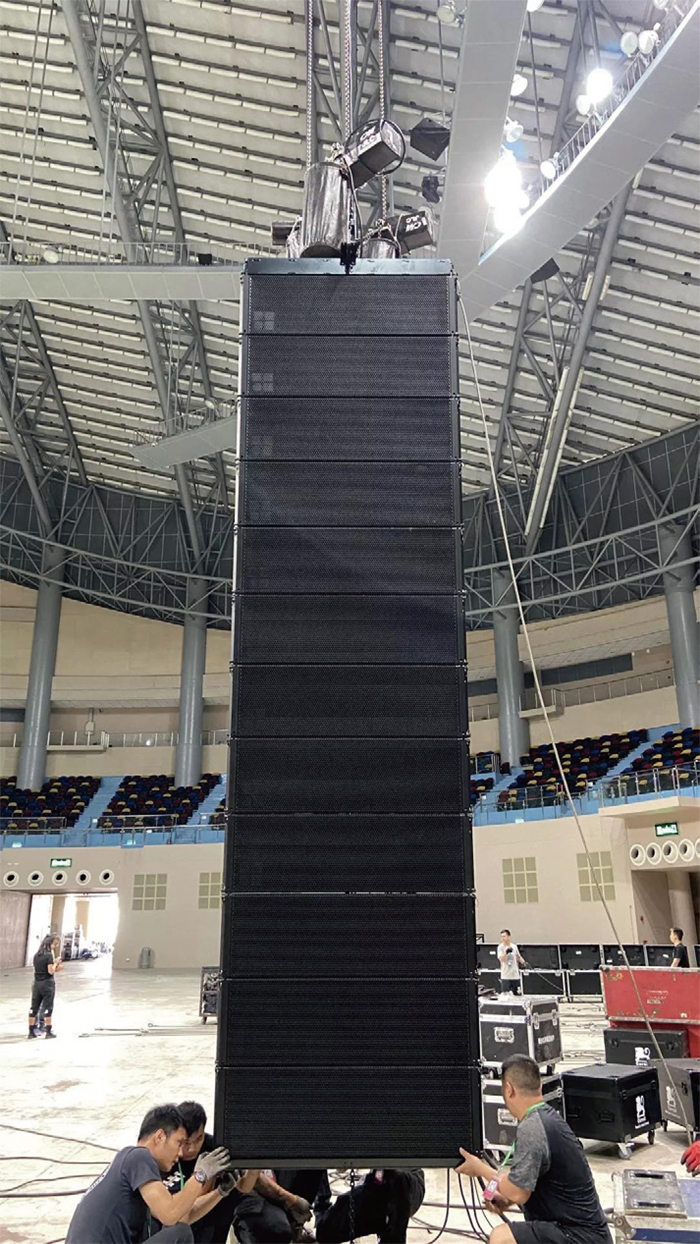
Figure 5 Main loudspeaker
The d&b GSL speaker has an excellent full-band sound control capability. It can deliver the energy of the sound to the area that needs to be covered (audience) according to the needs, while the sound leakage in other areas is very small, which makes the sound behind and below it Very "clean", which is conducive to the pickup of the orchestra and the stage. The sound field design is carried out by d&b’s computer calculation software ArryCalc and its unique AP (array processing) processing function (see Figure 6 and Figure 7), so that the sound coverage of the auditorium is very uniform, and the unevenness of the sound field is controlled at 6 dB within.
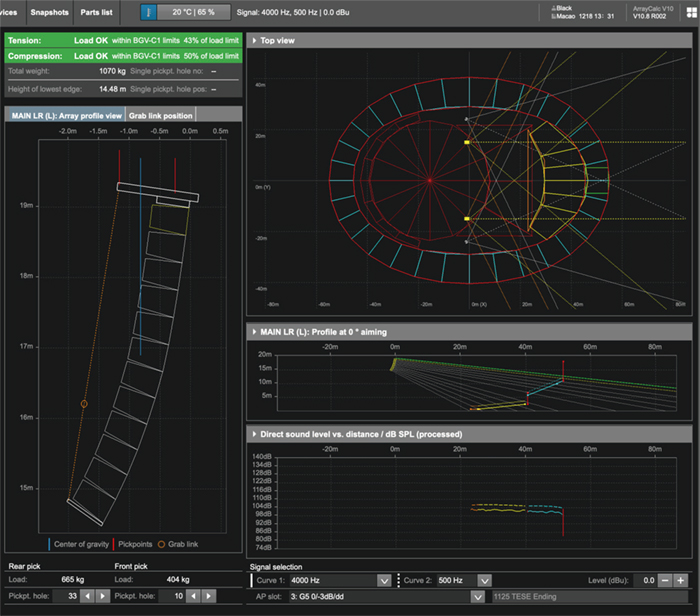
Figure 6 d&b ArryCalc calculation
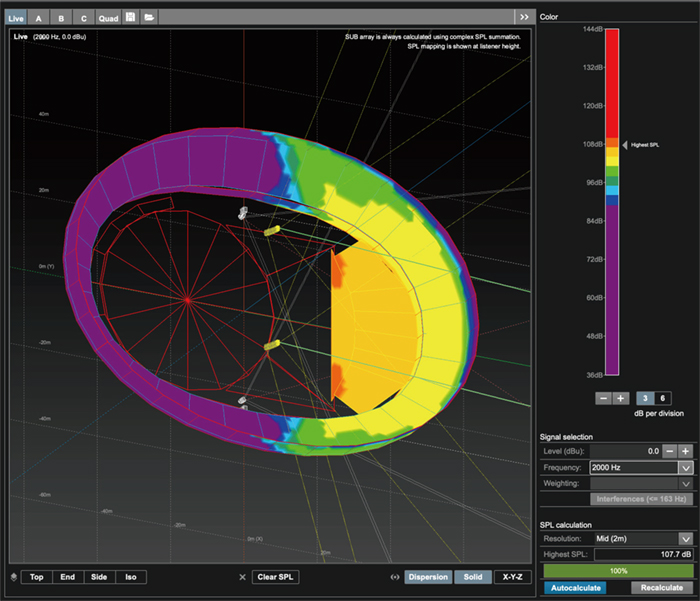
Figure 7 AP processing
In the post-rehearsal rectification, due to the adjustment of the viewing relationship, the VIP viewing area in the venue moved 10 m forward to the stage, which exceeded the coverage of the main amplifier speaker in the original design, and the ceiling hanging points have been Other work types are full, and the main amplifier speaker cannot be changed. For this reason, 4 d&b J8 speakers were installed on each side of the subtitle screens on both sides of the stage, and 4 L-Accoustic X8 speakers (see Figure 8) were installed in front of the orchestra to complement the sound. Solved this problem.
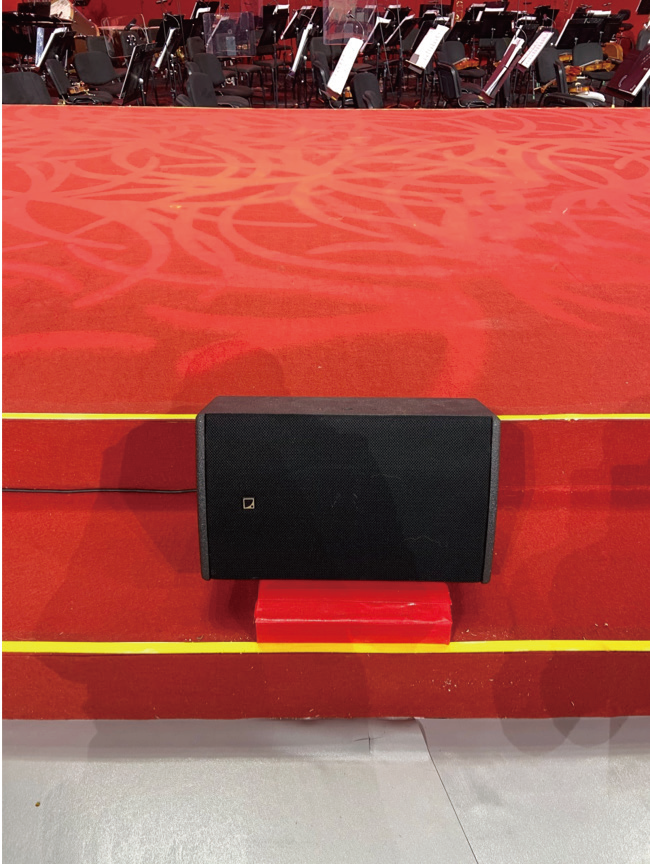
Figure 8 The front fill sound box of the orchestra
4 Adjustment of live sound
In this performance, the author is mainly responsible for the pickup and tuning of the symphony orchestra, the national orchestra and the chorus. The following focuses on the thinking, practices and experience gained from the work. In order to facilitate understanding and description, the symphony orchestra is called the Western Orchestra, and the National Orchestra is called the Chinese Orchestra. As mentioned earlier, the biggest feature of this performance in the configuration of the orchestra is the joint performance of the Western Orchestra and the Chinese Orchestra. The Western Orchestra is located in the left half of the orchestra, and the bass strings (cello, double cello) are located in the middle right area. The Chinese Orchestra is located in the right half of the orchestra. The Western Music and Chinese Orchestra share the bass strings and percussion parts.
Reasonable microphone setup is a necessary prerequisite for sound pickup, and also an important foundation for band and chorus sound reinforcement. Due to space limitations, I will not repeat them here. We can write another article to discuss with readers in the future. The author would like to focus on the joint performance of Chinese and Western orchestras, forming a huge mixed orchestra, which will inevitably form a mixed tone of western symphony music and national symphony music. This is the first situation that I have encountered since my work in sound reinforcement. This led to thinking about the mixed tone and voice balance of the United Orchestra.
The violin in the Western Orchestra is a plate-vibrating instrument, and the huqin in the Chinese Orchestra is a membrane-vibrating instrument. The timbre of the two is very different. Therefore, it is impossible and impossible to do simple timbre fusion. In the process of rehearsal and rehearsal, by carefully distinguishing the orchestration of different passages of each piece of music, and reading the score during the rest of the rehearsal, I clearly understood the primary and secondary relationship between the violin and the Huqin in different passages of different works. For example, in the work "Riding the Wind and Breaking the Waves and Starting Again", the Huqin accompaniment is prominent in the first verse, while the violin performance is very short and the volume is weak; while the second verse becomes a stronger violin. The long tone and accompaniment of Huqin are in a weak position. On the basis of understanding the composer's intention, the relationship between the two timbres of violin and huqin can be better balanced.
In terms of the handling of plucked strings, the Western Orchestra has no plucked parts except the harp, while the Chinese Orchestra has a huge plucked stringed part, and the composition of instruments is also very rich. Therefore, Chinese music has formed a very good timbre complement to Western music, and there is no excessive contradiction in tuning. For example, in the work "Liancheng Family", a large number of ethnic plucked instruments are used in the interlude. The close rounds of liuqin, pipa, and dulcimer suddenly make the work present a strong oriental charm.
For the wind instruments in the Chinese Orchestra, the flute part and the suona part took more on the task of playing traditional Chinese repertoires in this performance, and did not conflict with the woodwind and brass instruments in the Western Orchestra. Sheng has a good fusion in timbre, even in a mixed orchestra, the harmony function of the Sheng is also indispensable.
In short, for the mixed timbre of the United Orchestra, the customary principle is that when the overall style of the work is biased towards Western music, the Western orchestra is the mainstay, and the Chinese Orchestra is used to complement the Chinese tone; when the overall style of the work is biased towards the traditional Chinese, the Chinese orchestra is the mainstay. . For example, in the work "Haojiang Xiongfeng", Chinese martial arts and Chinese solo musical instruments have an important display. As the accompaniment music, mainly Chinese music, large sections of "General Order" appear in the music fragments, and the majestic Chinese martial arts The momentum is vividly contrasted. The band and chorus were adjusted in accordance with the above principles, and very good results were received on the spot. Both the PA and Monitor tuner used the mixed signal sent by the author instead of the group signal.
5 Adjustment of broadcast sound (OB)
With the development of science and technology, the sound quality and transmission technology of TV have been greatly improved, and people have new expectations for the sound heard in front of the TV. In particular, popular music programs like "The Voice of China", "I Am a Singer", and "The Summer of a Band" have higher standards and requirements for the quality of TV sound. People not only need to see a good picture, but also To hear good voices, so do live broadcasts. Therefore, it is a popular mode to make individual adjustments to the broadcasted sound instead of directly dividing the signal from the live sound reinforcement. This performance was broadcast live on TV and online by CCTV at home and abroad.
The adjustment of the broadcast sound should be done in a relatively independent space, but the room that can be provided for the broadcast sound production on site is not ideal. One is small, the other is the irregular shape of the room, and the third is the light board wall facing the sound. The reflection is very strong. Fourth, it is very close to the sound reinforcement site and the sound insulation effect is not good.
In response to these problems, some physical transformations were made to the room within the capacity. Through the coordination of the project manager Ma Wenzhao, the room was remodeled. First, a thicker stage with a black sky curtain was placed along the wall of the irregular room at a distance of 10 cm, and a layer of black velvet was layered on it. The cloth, which plays a certain sound absorption effect, reduces the disorder of excessive high-frequency reflection caused by irregular walls. At the same time, attach a thick black sky screen at a position 20 cm away from the top ceiling, so as to better offset the interference of low-frequency energy caused by sound reinforcement outside the room. Through this transformation, the sound effect of the room has been significantly improved, especially the high-frequency part of the border is gone, and the resonance of the external sound reinforcement is also reduced a lot.
After the physical space is processed, what needs to be solved is the difference between the on-site listening experience and the broadcast listening experience. This is a challenge faced by a broadcast tuner, especially this time. Since the three bands from left to right are symphony, folk music, and electroacoustics, the direct sound of the live symphony band is collectively to the left, the direct sound of folk music is collectively to the right, and the direct sound of the electroacoustic band is on the right. In the side corner. It is especially worth mentioning that because the width of the stage mouth is up to 40 m, the distance between the left and right main amplifier speakers is also this width. Therefore, the live PA tuner must integrate the adverse effects of direct sound and the wide distance. The width of the sound field generated by the speaker, the sound image positioning (pan) of the instrument is not to the extreme left or the extreme right. Many instruments have very small angles, and the on-site hearing is suitable, but when it is broadcast, the sound field suddenly becomes narrow and three-dimensional. The sense of depth is not reflected. How to solve the three-dimensional feeling and layering of the sound field in the broadcast is the difficulty that the author faces. After repeated analysis and thinking, the following solutions have been adopted.
(1) Enhance the signal and improve the signal-to-noise ratio to solve the depth and saturation of the sound field.
First of all, Neve’s PORTICO IIMBP is added to the output bus, which uses its superior compression and sound field enhancement functions to increase the signal, widen the space width and the sound field depth.
Secondly, a large number of band-pass filters are used to improve the signal-to-noise ratio of the human voice. Due to the large use of microphones, each chapter’s program is basically composed of several programs in series, plus a large symphony band of 80 people and a folk band of 60 people, if you don’t make a proper choice, the broadcaster The sound will be empty. Therefore, it is necessary to reasonably use band-pass filters to increase the human voice transmission gain to reduce the interference caused by environmental noise.
(2) Re-position the pan of each grouping signal, and according to your own understanding of the program, gather other monophonic instrument sources for secondary mixing.
For the overall band, a reasonable pan can extend the effective distance, adding a certain amount of delay to some parts, thereby increasing the band level is particularly important. To this end, the band tuner is asked to use the band’s mixing console to send 14 pairs of stereo grouping signals to the broadcast, and add different time delays to the grouping signals according to the pickup microphones in different positions to increase the overall The depth of the band can finally be combined with a very clear and layered sound source. Generally speaking, the expansion and depth of the sound field can not only be solved by adjusting the pan, but also by adjusting the loudness of various sound sources and factors such as insertion space and time.
(3) Reasonable use of monitoring environment
Like many recording studios, at least two pairs of monitor speakers of different models are placed for work. One pair is Genelec 8350, as the main monitor, and a pair of CLA-10 (white basin) as the comparative monitor. The main monitor is used as a near-field monitor. Since it is placed slightly in the middle, it is used as a monaural signal processing monitor. According to experience, it is not blindly widening the sound field to achieve the effect of improving sound quality. Sometimes on the contrary, the superposition of multiple sound sources will cause annoying phase problems. If you always use too wide stereo as a reference mix, once The part that changes to mono will suddenly disappear.
Therefore, the general usage is to mix and record with the main monitor first, then compare with stereo, and switch back and forth. In summary, through these technical means, the sound production of this broadcast has been successfully completed.
6 Summary
For such a high-level, large-scale, huge and complex performance, in addition to the above-mentioned technical aspects, coordination and communication with all parties are also factors that cannot be ignored. Especially when working in the SAR, the situation is even more complicated. In addition to coordinating relevant government departments such as the Ministry of Culture and Tourism and the Macao SAR, there are also customs, border inspections, and endorsements. There are many threads and complicated processes. This requires that the coordinator must not only be proficient in audio technology issues such as equipment configuration and sound field coverage, but also have the comprehensive coordination ability to organize and lead a technical team.
The sound engineer Ma Wenzhao acted as the project manager of this performance. Due to his careful and careful preparation and excellent coordination and communication skills in the early stage and the whole process, the sound team progressed smoothly and the cooperation in all aspects was extremely high. The sound technical team was the first technical group to enter the construction site, and its efficient work style won precious time for subsequent system debugging.
Multi-professional coordination of stage, sound, video, lighting, etc., as well as the deep integration with the party content, ensured the overall artistic effect of the party scene and TV broadcast, bringing a wonderful and diverse stage performance to the audience, and bringing Macau back to the motherland A generous gift was presented for the 20th anniversary.
Selected from "Performing Arts Technology" 2020 Issue 1-2 Shen Tian, Ji Haowei "Design and Implementation of Sound System for the 20th Anniversary of the Return of Macao to the Motherland", please mark the reprint: Performing Arts Technology Media. For more details, please refer to "Performing Arts Technology".